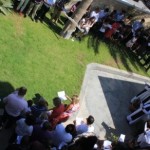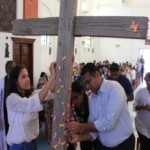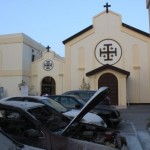Dean’s Blog – Holy Week and Easter 2018
Holy Week and Easter 2018
 Through this Holy Week and Easter the central act of what we have done in our worship has been to retell the story of Jesus’ last week in a variety of different ways and it has struck me afresh how powerful story-telling is and in particular the transforming power of this particular story. I was taking a school assembly on Palm Sunday morning and as I was telling the story I felt that some of the children were hearing this story for the first time: the shock of Jesus betrayal by Judas, the sadness hearing how Jesus friends abandoning him and Peter denying him, the difficulty of understanding the brutality of the violence against Jesus. And I have been reminded that the original Greek often uses the historic present tense – which in English is translated as past – but for those reading or hearing the story in the original language the reader/hearer is present.
Through this Holy Week and Easter the central act of what we have done in our worship has been to retell the story of Jesus’ last week in a variety of different ways and it has struck me afresh how powerful story-telling is and in particular the transforming power of this particular story. I was taking a school assembly on Palm Sunday morning and as I was telling the story I felt that some of the children were hearing this story for the first time: the shock of Jesus betrayal by Judas, the sadness hearing how Jesus friends abandoning him and Peter denying him, the difficulty of understanding the brutality of the violence against Jesus. And I have been reminded that the original Greek often uses the historic present tense – which in English is translated as past – but for those reading or hearing the story in the original language the reader/hearer is present.  That is we are not just observers of events that have happened, but we are present.
That is we are not just observers of events that have happened, but we are present.  In a very real way we are participants. And so the telling of the story and we have often done it though dramatic portrayal: in the Station of the Cross; in the washing of feet at the Maundy Thursday service; and in the powerful journey to the cross that we make in the Good Friday service. The whole congregation moves from the celebration of Passover in the Upper Room (Cathedral) to the Garden of Gethsemane (Deanery garden) to the place of judgement (Coffee room) to the place of crucifixion (back in the cathedral) and we make our own connection with the story by pinning our names to the large wooden cross.
In a very real way we are participants. And so the telling of the story and we have often done it though dramatic portrayal: in the Station of the Cross; in the washing of feet at the Maundy Thursday service; and in the powerful journey to the cross that we make in the Good Friday service. The whole congregation moves from the celebration of Passover in the Upper Room (Cathedral) to the Garden of Gethsemane (Deanery garden) to the place of judgement (Coffee room) to the place of crucifixion (back in the cathedral) and we make our own connection with the story by pinning our names to the large wooden cross.
 In the Good Friday three hour service, we explored the experiences of six people who were there: Mary of Bethany, Peter, Judas, Pilate, Mary Magdalene and the Roman Centurion using what I think is a deeply insightful book At the Cross by Richard Bauckham and Trevor Hart as the basis for the meditations. The service ended unexpectedly dramatically for as we were singing the final hymn a car was ablaze in the car park. There was some quick thinking and fire extinguishers and hoses were soon being used and the police and fire brigade were also soon on the scene, but the car was a right off and an adjacent one was badly damaged through the heat. Thankfully no-one was hurt, it was an electrical fault (not a terrorist act) and the petrol tank did not explode.
In the Good Friday three hour service, we explored the experiences of six people who were there: Mary of Bethany, Peter, Judas, Pilate, Mary Magdalene and the Roman Centurion using what I think is a deeply insightful book At the Cross by Richard Bauckham and Trevor Hart as the basis for the meditations. The service ended unexpectedly dramatically for as we were singing the final hymn a car was ablaze in the car park. There was some quick thinking and fire extinguishers and hoses were soon being used and the police and fire brigade were also soon on the scene, but the car was a right off and an adjacent one was badly damaged through the heat. Thankfully no-one was hurt, it was an electrical fault (not a terrorist act) and the petrol tank did not explode.
On Easter Eve I had a final meditation on Nicodemus, who, with Joseph of Arimathea, had taken responsibility to get permission from Pilate to take Jesus’ body and place it in a tomb. It shows the transformation from the Nicodemus of John 3, who comes under cover of darkness to meet with Jesus. Here he is publicly identifying with Jesus, which clearly demanded huge courage given his position as a Pharisee and on the Sanhedrin, the religious council and he gives Jesus a burial that was fit for a king with a huge quantity of myrrh and aloes. Had Nicodemus come “to see the Kingdom of God”, which were Jesus first recorded words to him in John 3: 3.
 Easter for me began by delivering Jesus and the angel to the Easter garden in preparation for the joint Tamil service at 5am and it was good to meet the Salvation Army Major, Stewart Grinstead who was the preacher and visiting from Kuwait. I then headed up to the American Mission Hospital car park for the Ecumenical Sunrise service at 5.30am; it’s always striking how many people gather before heading off to work on a working day for many. returning to the Cathedral to greet the Tamil community who were having breakfast. Our main Easter service was at 10.30am in the Cathedral and the Rev’d Sujith Sugathan, from one of our Church of South India congregations, helped lead the service, while Canon Stephen led the 9.30am service at Awali.
Easter for me began by delivering Jesus and the angel to the Easter garden in preparation for the joint Tamil service at 5am and it was good to meet the Salvation Army Major, Stewart Grinstead who was the preacher and visiting from Kuwait. I then headed up to the American Mission Hospital car park for the Ecumenical Sunrise service at 5.30am; it’s always striking how many people gather before heading off to work on a working day for many. returning to the Cathedral to greet the Tamil community who were having breakfast. Our main Easter service was at 10.30am in the Cathedral and the Rev’d Sujith Sugathan, from one of our Church of South India congregations, helped lead the service, while Canon Stephen led the 9.30am service at Awali.  Tricia and I managed a quick swim and fish and chip lunch at the British Club, which revived us for the final Easter Holy Communion at 6.15pm, the usual time for our regular Sunday service. I enjoyed the challenge of preaching on Mark 16:1-8, which ends not with Alleluias that Christ is risen, but the women, trembling and bewildered fled from the tomb and they said nothing to anyone for they were afraid. Fear which paralyzed them into running away and silence, as fear does. But why does Mark end in this way? – an ending that later scribes could not cope with so they added another for as our Bibles say: “the most reliable early manuscripts and other ancient witnesses do not have Mark 16: 9-20.” It is surely because he wants us, the hearers and readers of his gospel, to take up the responsibility of sharing the good news with others.
Tricia and I managed a quick swim and fish and chip lunch at the British Club, which revived us for the final Easter Holy Communion at 6.15pm, the usual time for our regular Sunday service. I enjoyed the challenge of preaching on Mark 16:1-8, which ends not with Alleluias that Christ is risen, but the women, trembling and bewildered fled from the tomb and they said nothing to anyone for they were afraid. Fear which paralyzed them into running away and silence, as fear does. But why does Mark end in this way? – an ending that later scribes could not cope with so they added another for as our Bibles say: “the most reliable early manuscripts and other ancient witnesses do not have Mark 16: 9-20.” It is surely because he wants us, the hearers and readers of his gospel, to take up the responsibility of sharing the good news with others.

